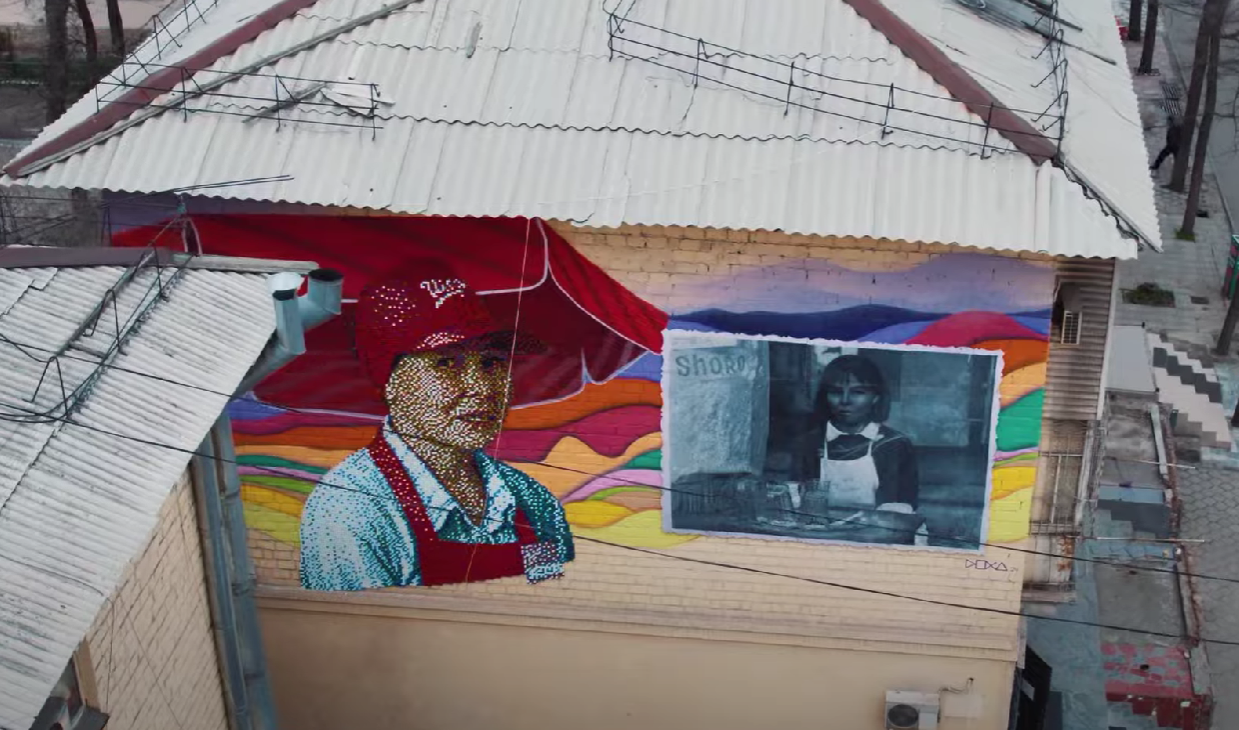
One of the four mosaics installed in Bishkek depicting the Shoro company employee Ainura Isaeva. Screenshot from video “Мозаики из пластиковых крышек появились в Бишкеке” from Kaktus Media YouTube channel. Fair use.
At the end of March, a group of environmental activists, journalists, and artists in Kyrgyzstan unveiled four new street art objects in the capital, Bishkek. They are made from 42,500 recycled plastic bottle caps and dedicated to standout figures whose indelible contributions in various fields remain unrecognized.
The team behind this project, which is called “Kadam” (Step), consists of Ainura Sagyn, the co-founder of the ecological organization “Tazar,” Dimitri Petrovsky, an artist of the Doxa Art Group, and journalist Rakhat Asangulova. Petrovsky spent three to four weeks on each installation, which involved painting portraits by gluing caps to sheets of alucobond, aluminium composite panels, and then mounting them on walls in different parts of the city.
Here is a YouTube video about the Kadam project.
The first mosaic depicts Ulan Zhaparov, an artist and architect who has helped transform Bishkek into one of the centers of modern art in Central Asia. Zhaparov is a pioneer of contemporary art in Kyrgyzstan. Over his career, he has organized numerous art events and supported dozens of artists and the development of interdisciplinary projects since the early 1990s. Zhaparov was present at the unveiling of his mosaic, and said he was glad that his “mark will remain” in the city.
The second mosaic depicts Zhibek Karakeeva, a former press secretary of the Bishkek’s municipal service “Tazalyk” (Cleanliness), responsible for maintaining the city clean and orderly. Karakeeva is credited with changing the public perception of Tazalyk employees by telling their stories, highlighting their work’s importance, and bridging the gap between them and the city residents.
Here is a post on Instagram with the four art installations.
Посмотреть эту публикацию в Instagram
The third mosaic depicts Avaz Momunaliev, a film projectionist, who was the only employee left at Kyrgyzstan’s Cinema House, after everyone left it in the early 1990s. Momunaliev stayed there, even after the organization stopped receiving funding and it fell into debt. Until 1999, he lived in the Cinema House and protected film equipment from looters. When the Cinema House started working again, Momunaliev continued to play films on the projector he saved, and worked there until he passed away in 2023.
The fourth mosaic depicts Ainura Isaeva, a so-called “Shoro ejeshka” (Shoro auntie), who has been selling Kyrgyz national beverages produced by the Shoro company for 28 years on the streets of Bishkek, making her the company’s longest serving employee. Bishkek residents associate Shoro employees such as Isaeva with the arrival of spring in the city, since they start selling drinks on the streets when the weather gets warm.
A representative of the Shoro company, which supported the project financially, noted that “garbage can remain just garbage in some hands, but in others it can become inspiration for creating something beautiful.”
The Kadam project is an example of an initiative by individuals who are passionate about bringing social change via creative means. Besides shining light on Bishkek’s unsung heroes, it brings to the fore the issue of increasing garbage and the need to recycle it by showing how it can be used to create art.
Petrovsky is famous for creating numerous street art objects that draw attention to important issues in Kyrgyz society, such as gender based violence and recycling waste. For Sagyn, the project is a opportunity to promote Tazar, an organization that educates citizens about the need to sort garbage, collects recyclable materials, and sends them for recycling. The team plans to create six more mosaics using caps in the remaining provinces of Kyrgyzstan. They, too, will introduce Kyrgyzstani people to their compatriots whose lifetime worth of work remains without recognition.






